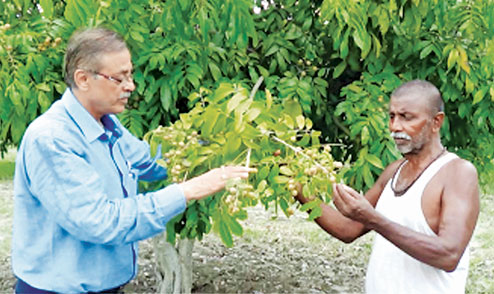 |
| Rajesh Kumar, the principal scientist of National Research Centre for Litchi, inspects a longan tree at Mehsi village in Muzaffarpur and (right) the fruits. Pictures by Lokesh Bihari |
After litchi made a mark, its cousin is trying to make a sweet presence in north Bihar.
Scientists of National Research Centre for Litchi in Muzaffarpur are doing an evaluation and propagation studies from 2004 to boost longan cultivation. Belonging to the litchi family, longan has been found suitable for growth in the state’s northern belt.
Dimocarpus longan, commonly known as the longan, is a tropical tree that produces edible fruit. It is one of the better-known tropical members of the soapberry family, to which the litchi also belongs. It is native to southern Asia.
The longan, whose literal meaning is dragon eye, is so named because it resembles an eyeball when its fruit is shelled. The black seed shows through the translucent flesh like a pupil. The seed is small, round and hard, and of an enamel-like, lacquered black.
The fully ripened, freshly harvested shell is bark-like, thin, and firm, making the fruit easy to shell by squeezing the fruit out as if one is “cracking” a sunflower seed.
Commercially grown parallel to litchi in China, Thailand and Vietnam, north Bihar, can also produce this fruit now. Recent studies by the National Research Centre showed that the longan is performing on a par with litchi. The centre’s scientists distributed experimental plants in Minapur, Mehsi and Kanti among litchi growers. Now, the plants are flowering and bearing fruits.
The principal scientist of the centre, Rajesh Kumar, said: “Longan remained neglected here. The research has been done for its improvement and perfection. Because of the woody appearance of the skin and dull yellow colour of longan, the fruit has remained an unviable proposition among the farmers.”
He said the preliminary evaluation after working on the crop indicated that the fruit was high-yielding, late maturing and sweeter than the China varieties of litchi.
Till date, pest infection has also been found negligible. The longan provides enough nectar and pollen to honeybees when litchi flowering is over in April. The fruition period of longan is August to October. Studies have found that honeybees enhance fruit yield for longan.
“After the distribution of plants, the pattern and tendency of its flowering and fruition has shown encouraging results,” said Shambhu Sharma, a longan farmer in Kanti.
He added that longan production in north Bihar would prove beneficial in crop diversification and availability of litchi group of fruits. There is also a high scope in processing industries and value addition such as canned food, ready-to-serve drinks and squash.
The farmer has sought intervention of National Horticulture Mission and National Horticulture Board to initiate efforts in supplying plant and fertiliser to longan producers in north Bihar.
Longan is used as remedy for stomachache, insomnia, amnesia, and dropsy. The fruit is said to invigorate the heart and spleen, nourish the blood and have a calming effect on the nervous system.
A decoction of the dried flesh is taken as a tonic and treatment for insomnia and neurasthenic neurosis. In Vietnam, the “eye” of the longan seed is pressed against snakebite victims in the belief that it will absorb the venom. The seeds are administered to counteract heavy sweating, the pulverised kernel, which contains saponin, tannin and fat, serves as a styptic (substance that draws together or constricts body tissues and is effective in stopping the flow of blood or other secretions).











